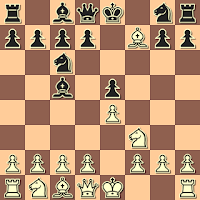Wall, Bill - Ryusak
lichess.org, 2016
1.e4 e5 2.Nf3 Nc6 3.Bc4 Bc5 4.Bxf7+
4...Kxf7 5.Nxe5+ Nxe5 6.d4 Bxd4 7.Qxd4 d6
8.O-O Nf6 9.Nc3
9.f4 was seen as early as Jerome,A - Shinkman,W, Iowa, (1/2-1/2, 42).
The more restrained 9.f3 was seen in Wall,B - Guest903719, PlayChess.com 2013 (1-0, 47).
More recently Bill has tried 9.Bf4 Be6 10.Nc3 Re8 11.Rad1 Nc6 12.Qd2 Bg4 13.f3 Bh5 14.Nd5 Nxd5 15.Qxd5+ Kf8 16.Qxh5 Kg8 17.Qd5+ Kh8 18.c4 Nb4 19.Qb5 a5 20.a3 Nc2 21.Rf2 Qf6 22.Bg5 Nd4 23.Qxe8+ Rxe8 24.Bxf6 Nxf3+ 25.Rxf3 gxf6 26.Rxf6 Rxe4 27.c5 Re2 28.Rf7 Rxb2 29.cxd6 Kg8 30.Rxc7 Kf8 31.d7 Black resigned, Wall,B - Guest3687203, PlayChess.com, 2015.
9...b6
One of a number of defenses that Bill has faced:
9...Re8 10.Bg5 (10.f4 Nc6 11.Qd3 Kg8 12.Bd2 Kh8 13.f5 Ne5 14.Qd4 c5 15.Qf2 Rf8 16.Rae1 Nfg4 17.Qg3 Qb6 18.b3 c4+ 19.Kh1 cxb3 20.Nd5 Qd8 21.axb3 b6 22.c4 Bb7 23.Nf4 Nf6 24.Ne6 Qe7 25.Nxf8 Rxf8 26.Bg5 Qf7 27.Bxf6 Qxf6 28.Re2 g6 29.Kg1 a5 30.Qf2 a4 31.bxa4 Nxc4 32.fxg6 Qxf2+ 33.Rfxf2 Rxf2 34.Kxf2 hxg6 35.Rc2 Ba6 36.Kg3 Kg7 37.Kf4 Kf6 38.h4 Ne5 39.Rd2 Nd3+ 40.Ke3 Ke5 41.Rxd3 Black resigned, Wall,B - Ferreira,J, lichess.org 2016) 10...h6 (10...Kg8 11.f4 (11.Nd5 Be6 12.Bxf6 gxf6 13.Rad1 c6 14.Nf4 Qb6 15.Qc3 Qc7 16.Rd4 c5 17.Rd2 Rad8 18.Rfd1 Qe7 19.f3 b6 20.b3 Ng6 21.Qe3 f5 22.Nxg6 hxg6 23.exf5 gxf5 24.Qh6 Qg7 25.Qxg7+ Kxg7 26.Rxd6 Rxd6 27.Rxd6 Kf6 28.c4 Ke5 29.Rd2 a6 30.Kf2 b5 31.cxb5 axb5 32.Re2+ Kf6 33.Kg3 c4 34.bxc4 bxc4 35.h4 c3 36.Rc2 Rc8 37.Kf4 Bxa2 38.Rc1 c2 39.Ke3 Bb3 40.Kd4 f4 41.Kd3 Rd8+ White resigned,Wall,B - Guest4809124, PlayChess.com 2013) 11...Nc6 12.Qa4 (12.Qd3 Nb4 13.Qc4+ Be6 14.Qxb4 b6 15.Rae1 c5 16.Qb5 d5 17.e5 d4 18.exf6 a6 19.Qc6 Bd7 20.Qd5+ Kh8 21.fxg7+ Kxg7 22.Bxd8 Black resigned, Wall,B - Foman, Chess.com 2010) 12...Bd7 13.Rae1 h6 14.Bh4 Ne5 15.Qb3+ Nf7 16.e5 dxe5 17.fxe5 Be6 18.Qa4 Bd7 19.Qd4 g5 20.exf6 gxh4 21.Rd1 Nd6 22.Qd3 Bf5 23.Rxf5 Nxf5 24.Qxf5 Qxd1+ 25.Nxd1 Re1+ 26.Kf2 Rxd1 27.Qg6+ Kf8 28.Qg7+ Ke8 29.Qe7 checkmate, Wall,B - U80, PlayChess.com, 2016) 11.Bh4 c5 (11...Be6 12.f4 c5 13.Qa4 Ng6 14.Bxf6 gxf615.f5 b5 16.Qxb5 Bd7 17.fxg6+ Kxg6 18.Qd3 Kg7 19.Qxd6 Rc8 20.Rad1 Rc7 21.Qg3+ Kh7 22.Nd5 Rc6 23.Nxf6+ Rxf6 24.Rxf6 Qxf6 25.Rxd7+ Black resigned, Wall,B - Guest1561957, PlayChess.com 2014) 12.Qd2 Be6 13.Rad1 Nc4 14.Qc1 Qb6 15.b3 Ne5 16.Bxf6 gxf6 17.f4 Ng4 18.f5 c4+ 19.Kh1 Nf2+ 20.Rxf2 Qxf2 21.fxe6+ Rxe6 22.Rf1 Qd4 23.Qxh6 Qxc3 24.Qh7+ Ke8 25.Qg8+ Kd7 26.Qxa8 cxb3 27.Qxb7+ Qc7 28.Qxc7+ Kxc7 29.cxb3 Rxe4 30.Kg1 Re6 31.h4 d5 32.h5 Kd6 33.g4 Ke7 34.Kf2 Kf7 35.Rc1 Re7 36.Kf3 d4 37.Rc6 Rd7 38.Ke2 d3+ 39.Kd2 Rd4 40.Rc7+ Kg8 41.Rxa7 Rxg4 42.Kxd3 Rh4 43.a4 Rxh5 44.a5 Rb5 45.Kc4 Rb8 46.a6 f5 47.Rb7 Ra8 48.a7 Black resigned, Wall,B - Guest5111265, PlayChess.com 2014;
9...c6 10.f4 Ng6 (10...c5 11.Qf2 Neg4 12.Qd2 Rf8 13.h3 Nh6 14.e5 Nh5 15.g4 Ng3 16.Rf3 Qh4 17.Kg2 Bxg4 18.hxg4 Nxg4 19.Qd5+ Ke7 20.Qxb7+ Ke6 21.Qd5+ Kf5 22.Qd3+ Ke6 23.Qxd6+ Kf7 24.Qd5+ Kg6 25.Rxg3 Qh2+ 26.Kf3 Qf2+ 27.Kxg4 Rxf4+ 28.Bxf4 h5+ 29.Kh4+ Kh7 30.Qe4+ g6 31.Qxg6+ Kh8 32.Qg7 checkmate, Wall,B - Guest708676, PlayChess.com, 2016) 11.Be3 Re8 12.Rad1 Bg4 13.Qc4+ Kf8 14.Rxd6 Nxe4 15.Rxd8 Raxd8 16.Nxe4 b5 17.Bc5+ Ne7 18.Bxe7+ Rxe7 19.Qxc6 Be2 20.Re1 Bc4 21.b3 Bd5 22.Qc5 Rdd7 23.Ng5 Rc7 24.Qd6 Rcd7 25.Qb8+ Black resigned, Wall,B - Uscanac, lichess.org, 2016;
9...c5 10.Qd2 Nc4 11.Qd3 Be6 12.f4 Bg4 13.Qxc4+ Be6 14.Qb5 Black resigned, Wall,B - TryToBeg, lichess.org, 2016; and
9...Rf8 10.f4 Nc6 11.Qd3 Kg8 12.Bd2 Be6 13.Rad1 a6 (13...Bf7 14.Nd5 Nxd5 15.exd5 Bg6 16.f5 Ne5 17.Qh3 Be8 18.Rf4 Qf6 19.Qg3 Bb5 20.a4 Bd7 21.Rdf1 Rac8 22.b3 Rce8 23.c4 b6 24.Bc3 Rf7 25.h3 c6 26.dxc6 Bxc6 27.Rd1 Qe7 28.Bb4 Rf6 29.Kh2 Bb7 30.Qf2 g6 31.Qg3 Kh8 32.Rfd4 Rxf5 33.Rxd6 Rg5 34.R6d2 Rxg3 35.Bxe7 Rxb3 36.Bf6+ Kg8 37.Rd8 Kf7 38.Rxe8 Kxf6 39.Rf1+ Kg5 40.Rxe5+ Kh6 41.Rf7 Ba6 42.g4 Rb2+ 43.Kg3 Rb3+ 44.Kf4 g5+ 45.Rxg5 Bxc4 46.Rf6 checkmate, Wall,B - Anonymous, lichess.org, 2016) 14.Nd5 Bg4 15.Rde1 Bh5 16.Bc3 Nxd5 17.exd5 Ne7 18.f5 Bf7 19.Qd4 Black resigned, Wall,B - Anonymous, lichess.org, 2016.
10.f4 Ned7 11.e5 dxe5 12.fxe5 Nxe5 13.Qxe5 Re8
He has forgotten the old saying: When White equalizes in the Jerome Gambit, he has the advantage. How else to explain the quick end to the game?
14.Qg3 Qd4+ 15.Kh1 Ba6 16.Bh6
A nice sacrifice that moves the advantage in White's direction.
16...gxh6 17.Rad1 Qg4
Black had to try 17...Bxf1 18.Rxd4 Bxg2+, although White would still have an edge after 19.Kg1!?
Now Black loses his Queen, and checkmate is forced.
18.Rxf6+ Kxf6 19.Qxg4 Black resigned






























.png)
.png)
.png)
.png)















